
Fall 2023 Enrichment Update
Scroll through this post to see what our students have been up to in our Enrichment classes this fall.
Art Enrichment
Jackie Dorr

This semester in Lower Elementary Art, the students built mosaic nature sculptures. Then they began a unit on drawing where the students had a guided drawing lesson on how to draw scarecrows in a crop field. We had a lengthy discussion where they were encouraged to make their scarecrows unique and their own. After drawing the scarecrows, the students outlined their pencil drawing with oil pastels. Lastly, we had a discussion about color theory as they painted their scarecrows. They were encouraged to create their own shades and tints of colors as they painted their drawing in their own, unique way.
In Upper Elementary Art, we’ve been bringing a lot of nature into our work. Upper Elementary just finished painting watercolor galaxies where they learned very carefully how to blend colors together. Most recently, we have looked at the works of Andy Warhol, specifically his pop art. Inspired by Andy’s work, we’ve been exploring printmaking with sunflowers. In early November, we are going out into nature to collect items to use for our printmaking work. At this point, the students have experimented enough with printmaking to be familiar with it. They are encouraged to experiment, be creative, and really dive deeply into making their work their own.
Physical Education
Coach Bry Huston
In Physical Education class, students at all levels focused on developing throwing skills. We engaged in activities that supported underhand and overhand throwing while still supporting body movements, body awareness, and body control.

Music Enrichment
Jackie Dorr
Children’s House students have been learning how to sing and play a c major scale on the bells. I can mix up the order of the bells and have the students put them back in the appropriate places to create a scale. We are also focused on developing their singing voices while incorporating songs about nature and Halloween.
This semester in Lower Elementary music classes we’ve been focused on learning how to read music. The classes learned a song on the steel pans by ear, and then learned how to write out the song on a musical staff. (See attached video)
In Upper Elementary music, students have been analyzing the music for Sweet Child of Mine by Guns & Roses. After they analyzed the music, they were asked to go find an instrument they connected to so they could start learning the music they had just analyzed.
In addition, as we have begun preparing for the Winter Show, they have also analyzed some steelpan music and are currently working on how to perform the music they analyzed. There has been a huge focus on note reading as well as rhythmic development and putting pieces together as one big ensemble.
In Adolescent Creative Arts, the students have been working diligently writing their own piece of music together as a band.
Spanish Enrichment
Ale Equivel Castillo

Children in our Spanish Dual Langauge Program have been learning about the Mayan celebration of Hanal Pixan, and the Mexican holiday of Dia de los Muertos! The children created decorations for their ofrenda. The Lower Elementary students are also making sugar skulls in honor of the holiday.
Children’s House students have been learning colors, family members, animals, numbers in Spanish. Children’s House elders (kindergarten year) create booklets to strengthen their Spanish reading and writing as well.
Library and Media Lab
Sherry White

Every Children’s House class has a weekly story time visit followed by a book checkout. Students are introduced to the skills and concepts needed to navigate the library, such as selecting a book, check-out procedures, book care, and the parts of the library. Library books are circulated for a period of one week. Each class has a scheduled library day and books need to be returned the following week in order to check-out additional books. Each library visit includes a purposeful read-aloud. Some of our stories this month have been My Autumn Book, How Many Seeds in a Pumpkin, The little Blue Cottage, and In the Middle of Fall.
Lower Elementary students visit the Media Lab once a week to build their keyboarding skills using edclub.com. This online resource is used to teach correct finger-to-key movement across the entire keyboard. It is a highly effective tool that helps students at all skill levels improve their typing ability through guided lessons and engaging assessments. The student experience is designed to be clean, straightforward, engaging, and fun. It is a highly effective tool that helps students at all skill levels improve their typing ability through guided lessons and engaging assessments. Students are provided with continuous feedback on their progress every step of the way and are motivated to repeat each lesson to master each step prior to proceeding. Students are provided with an optional virtual keyboard and virtual hands on their typing interface to assist them when using the correct fingers when they are practicing each lesson. The carefully designed lessons include instructional videos, educational games, cross-curricular content, and other interactive experiences.

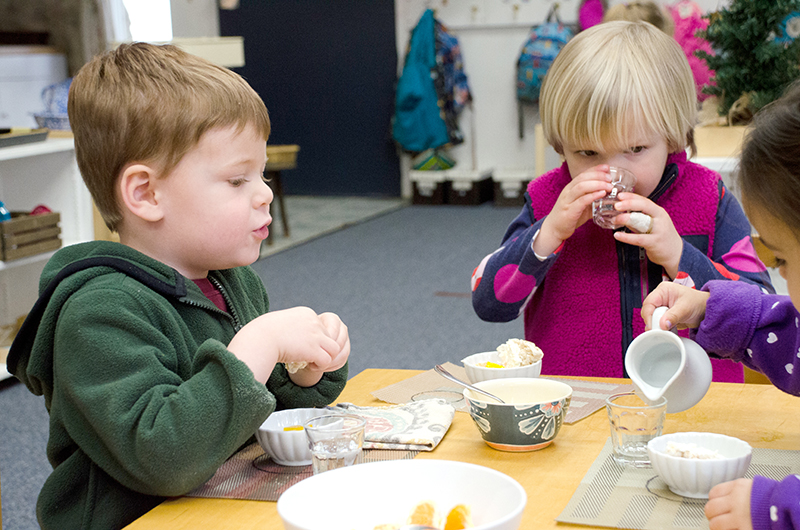
Developing Rich Language with our Toddlers

Rich oral language is a building block for strong literacy
Learning to be – this is every toddler’s goal. It is both simple and richly complex. Between the ages of 2 and 3, the child is newly aware of possessing their own identity separate from their family, and they are ready to truly be that person, with full independence.
A critical element of this self-realization is the ability to communicate. The toddler is beginning to understand conversational language and they are working to express their own thoughts, experiences, and feelings. They are yearning to label every object in their environment and know every detail of the work they find in the classroom. They are reaching for the words to seek help effectively in moments of struggle. In the Montessori method, we approach the toddler’s sensitive period for learning oral language strategically to help ignite their understanding of language and the world.
Developing Skills in the Toddler Classrooms:
- Attention
- Auditory memory
- Indirect preparation for written language
- Self-confidence with increased vocabulary

Early conversation is essential for child development
One of the most crucial elements of a toddler’s journey in language is conversation. In Montessori, we believe that the most powerful way to learn a skill is through practice, and conversations provide the ultimate “learning by doing” experience. The conversations that toddlers have with adults in the classroom provide them with richness – the knowledge that they are respected and seen, they feel valued for their opinions and feelings, and an opportunity to practice articulation with someone who can echo words back to them with exact pronunciation. These conversations provide them with a model of conversational etiquette and flow. It is through conversation that the young child learns the confidence to express their heart. Through this process, toddlers learn the functions of conversation—conflict resolution, self-expression, storytelling, clarification, and so on. In the Montessori classroom, we aim to converse with children throughout the morning—upon arrival, between a child’s tasks in the work cycle, and especially at the snack table. Any item in the room, event in our day, or thought from a child becomes a worthy and captivating topic.
Directive vs Expressive Language
Conversations between adults and children are spontaneous and natural in our Toddler classrooms, with the adults focusing on receptive and expressive language. Receptive language refers to what children can understand, such as following directions. Expressive language refers to what they can communicate with words and/or gestures. Adults minimize directive language (e.g., “Put your shoes here. Sit down. Wipe your nose.”) to provide space for meaningful, rich conversation.
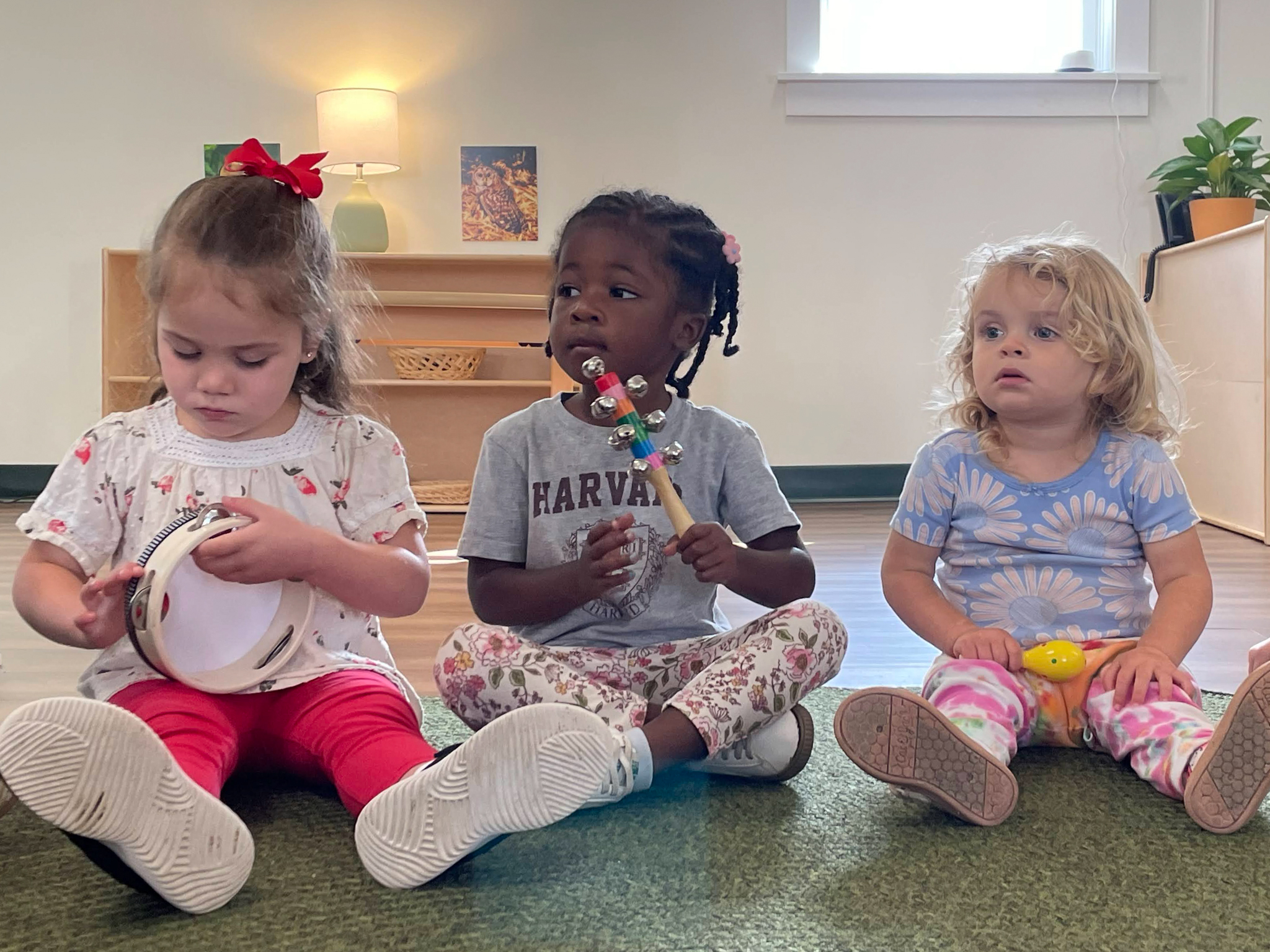
The gift of music
We also use poems and songs to introduce new language to children. Rhythm and cadence can help children hear words more clearly. Poetry and music can also bring concepts to the child’s mind in a manner that connects them with his heart. We often give toddlers the option to sing or review poetry as a group, and these activities are available in the classroom for individual work or lessons.
With all these language tools in his belt, the toddler is ready to take on the world and build himself into the world citizen that he was meant to be. He will take with him all his accurate knowledge, confident self-expression, and the songs in his heart, and will approach the world with compassion and curiosity.
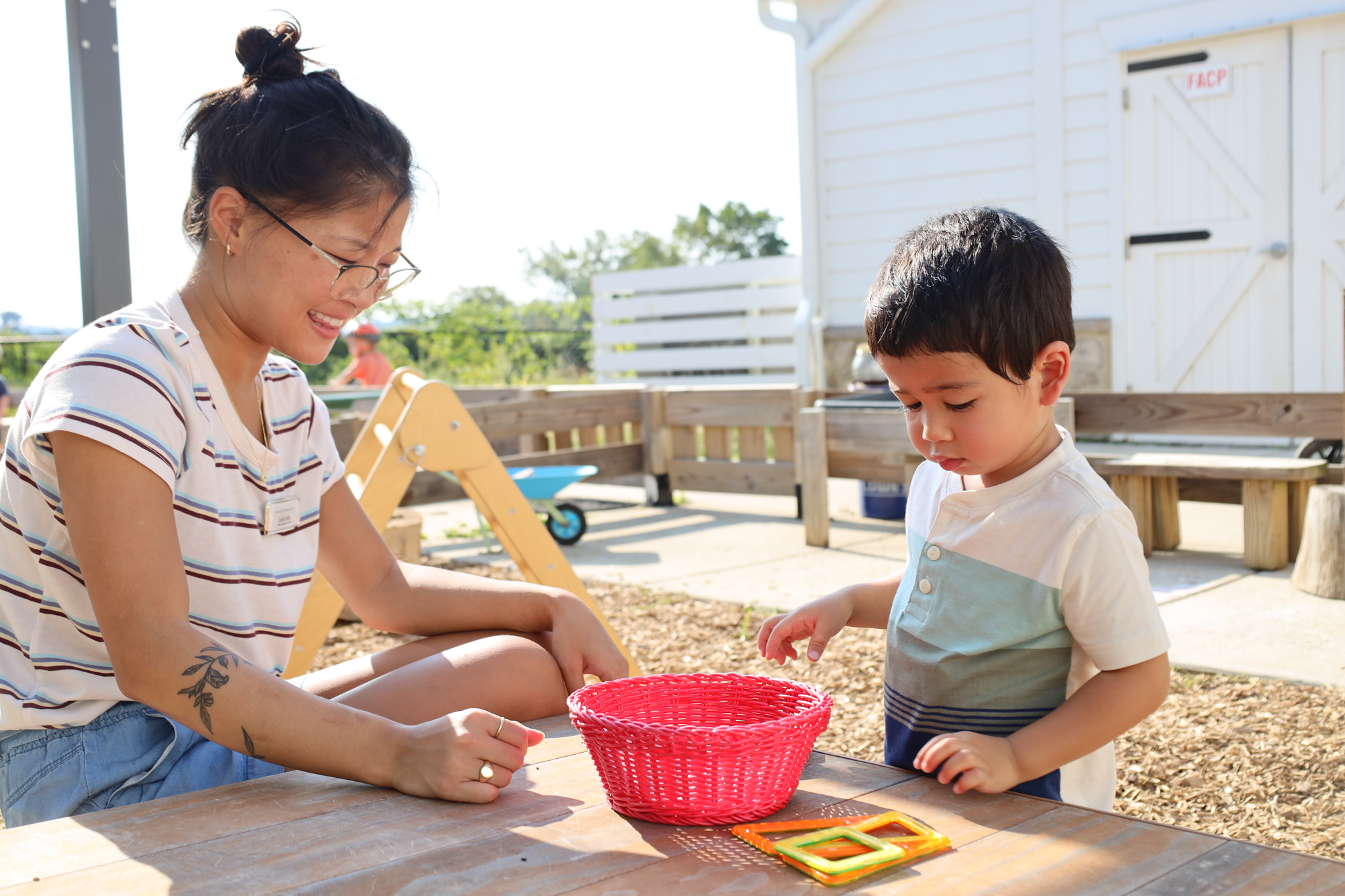
Speak clearly and truthfully to the child
Accurate language is another crucial tool for building a toddler into an effective communicator. Children create themselves from the tools they are given, so it is fundamentally important to communicate with children clearly and accurately. As we model speech, we enunciate as precisely as possible, and echo back correct pronunciation of the child’s mispronounced words in natural conversation. Beyond enunciation, we strive to give the child exact names for the elements of his environment and a detailed understanding of his world. In our Montessori environments, we provide children with exact names for every item in our environment, and for each of its parts. Baskets on the shelfs contain unique pictures and objects, exposing the children to new and interesting things.
Additionally, true stories give toddlers a unique learning opportunity. They provide details about the world the child would not otherwise have, as well as an understanding of the concepts of beginning, middle, and end. These stories help children understand how life happens in the real world – an understanding that they desperately crave. We also gift children with the opportunity to tell their own stories. Nothing is more beautiful than hearing the story about his baby sister that he is bouncing in to tell us. Storytelling is a daily part of our community life, and anything can serve as inspiration, from our family and friends to our breakfast.
Toddlers have a need to understand the world, and part of that is learning to differentiate between facts and opinions. In our classroom, we introduce both concepts on a daily basis. We let the child know that the details provided in lessons are facts, and ask them what they think of pictures in books. We help them understand the difference between those true details learned in lessons and the opinions that are expressed.
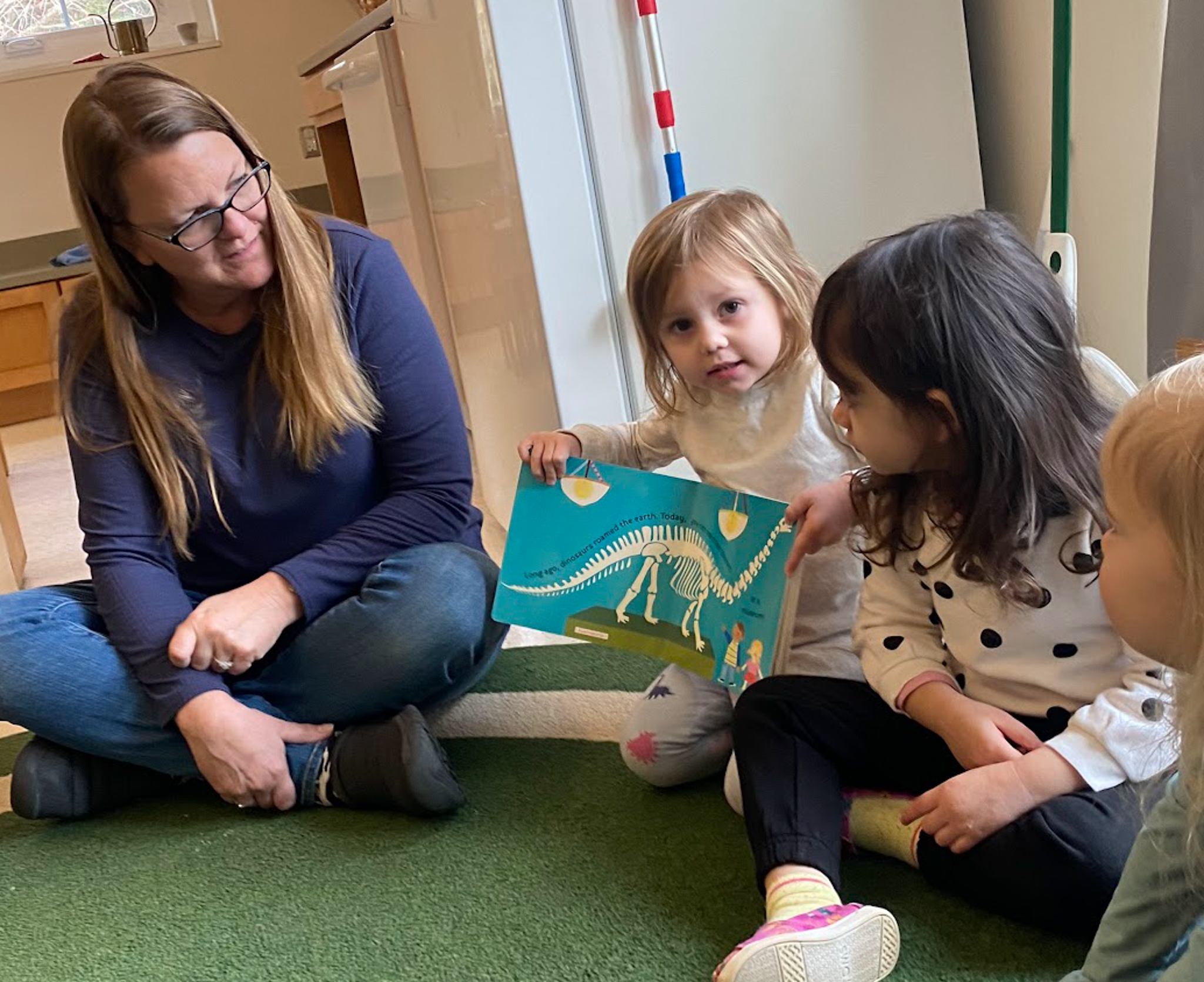
Learn more about our Toddler Program
Our Toddler Montessori Program serves children ages 18 months to 3 years at Greenspring Montessori School. Click here to learn more.
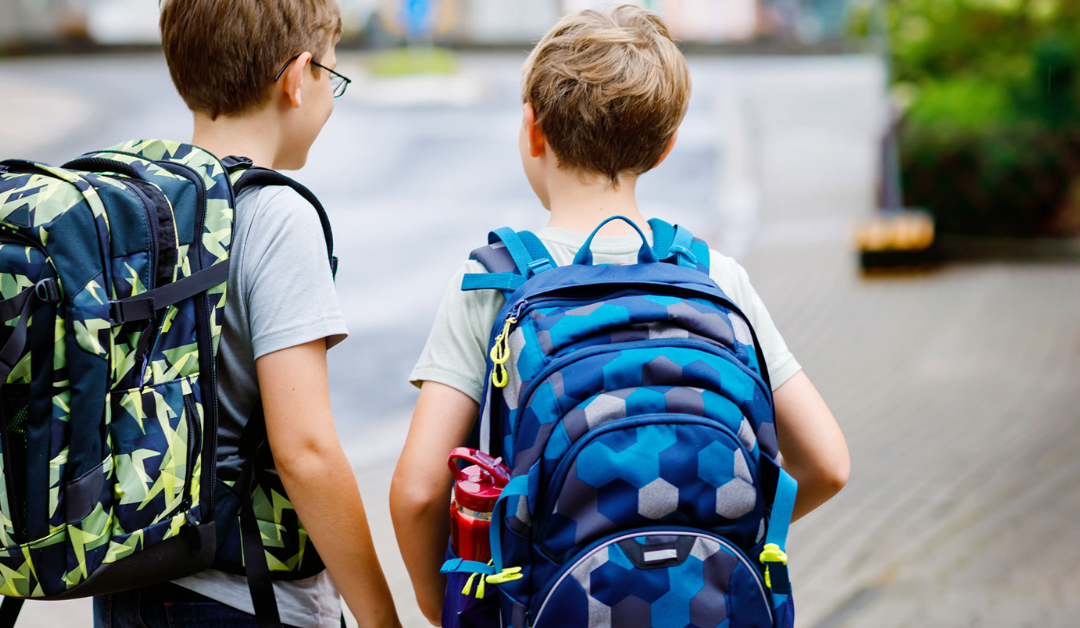
Why Cartoon-Character-Free?
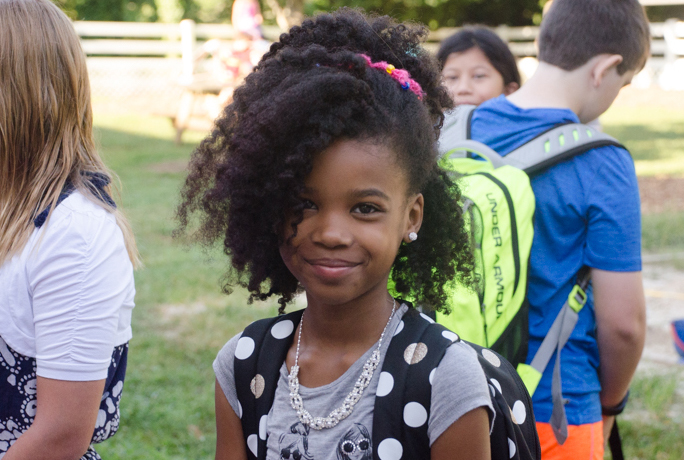
Our goal is to create a non-commercialized environment for our children. We are fostering an environment where we minimize outside distractions and pull for their attention, allowing the child’s imagination and creativity to take root without having to compete with the powerful call of the modeling of these commercial images and stories.
Our commitment is to creating prepared environments for optimal learning, exploration, creativity, and discovery. A child’s concentration is initially fragile, needing care and protection to develop and strengthen. Concentration, when cultured and grown, is what allows the child to focus on big work, think through problems, find creative solutions, and build both knowledge and understanding.

Parents, grandparents, and caregivers can help us build and preserve the children’s focus. Please send children to school with character-free clothing, shoes, backpacks, lunch boxes, thermoses, water bottles, bedding (for nappers), etc. We also ask that shoes not have lights on them, as these are very distracting: many of our students are working on the floor, so every time the light-up shoes walk by, their attention is pulled from their work.
Please help us cherish and nurture concentration to help it propagate and flourish!

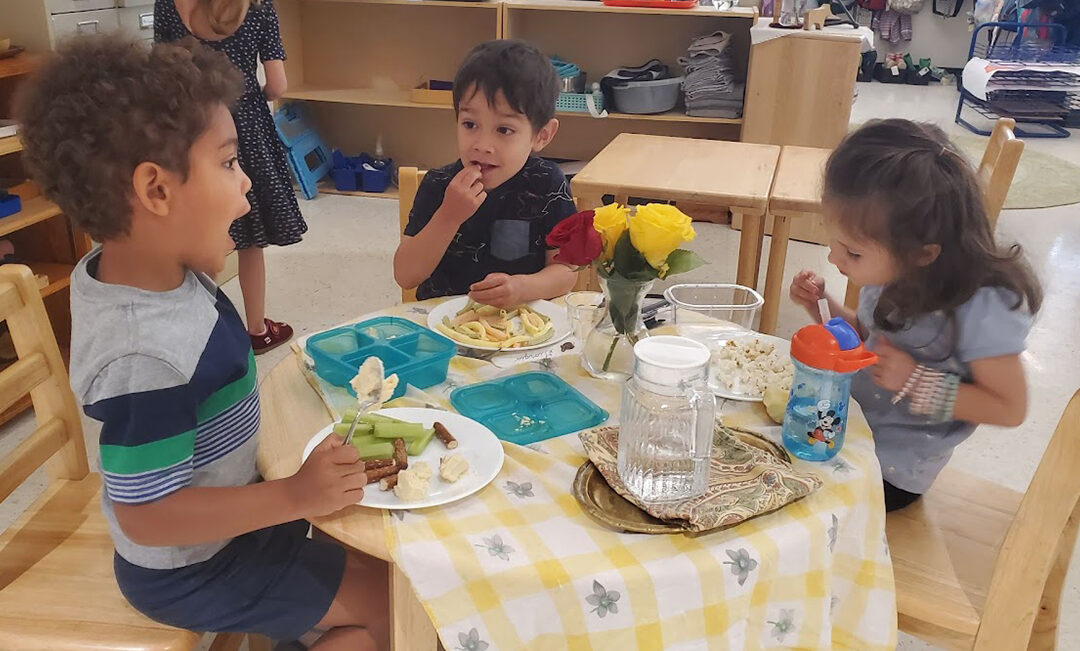
Preparing a Beautiful Meal in the Montessori Classroom
Preparing a Beautiful Meal is a daily Montessori practice in which children take ownership of creating a beautiful space for eating together. Beginning with our youngest children in the Toddler classrooms, these practices are instilled daily. The children are responsible for the setup each day, including laying a tablecloth or placemats, folding cloth napkins, and carefully carrying glasses, utensils, and glass or ceramic dishes. You will often see flowers on the tables that the children have arranged and placed to make the table more beautiful.
Children also participate in the clean-up process, including clearing the table, washing dishes, wiping down tables, and sweeping the floor. You see children collaborating and problem-solving during the process of setting up and cleaning up. Even cleaning up a spill or a broken dish is part of the learning!
Above: Toddlers prepare snack and sit together for a beautiful meal.
During the meal, students have the opportunity to practice the Grace and Courtesy skills they have learned. For example, the children practice table manners, such as starting the meal together once everyone is seated, putting napkins on their laps, using utensils properly, chewing with their mouths closed, and excusing themselves from the table. They also practice conversational skills, such as taking turns speaking and asking each other questions.

We intentionally create these spaces for the children to engage with one another. For some, this may be the only meal of the day when they are able to sit down with others and engage in conversation. The children are in a sensitive period for developing these close bonds and sitting at a table together is an opportunity to meet those essential developmental needs.
How can families support in this initiative?
The case for real plates
You may have seen many adorable plastic bento boxes in your back-to-school shopping, however, we find that these can be challenging for children to open and scoop their food onto their plates. The same is true for squeeze yogurts and foods in plastic packaging. These are excellent for families when you are on the go, but they are often difficult for the children to enjoy in the classroom.
With a Montessori beautiful meal, children empty the contents of their lunch onto a plate and/or bowl for a few reasons. First, it helps to create an atmosphere of a sit-down meal at home. And second, it gives them the opportunity to practice very precise fine motor skills of scooping with a spoon or fork. We are finding that more convenient items, such as squeeze yogurts and perfectly portioned bento boxes delay the child’s precision with some of those table skills.
If you have more questions about how our Beautiful Meal will work in your child’s classroom, please reach out to your child’s Guide. We are so excited to be able to move back to this beautiful and important structure!

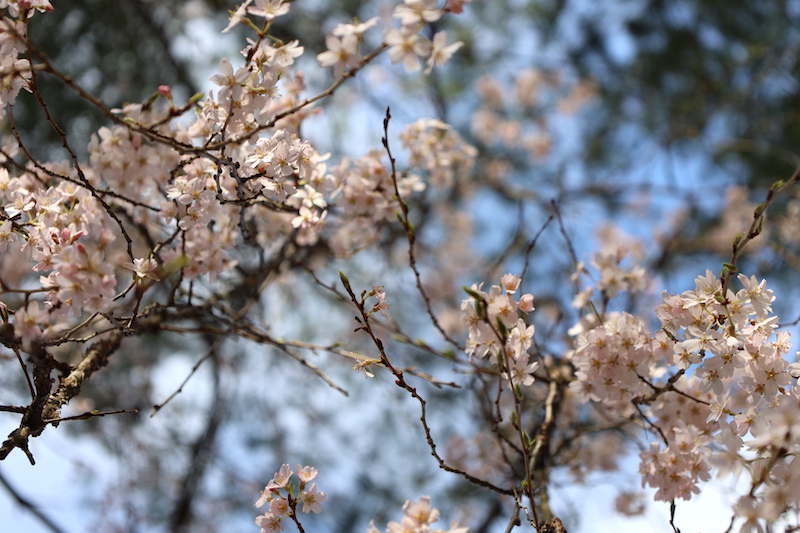
Spring in Our Outdoor Environments
Monday, March 20th was the first day of spring and our students are celebrating in their outdoor learning enironments!
Students at Greenspring learn how to care for their outdoor environments from our youngest ages. Outdoor work includes watering and weeding the garden, sweeping, and planting seeds and new plants. Older children scrub fences and even build raised beds. These practical activities build a sense of connection and ownership as children care for the natural spaces around them.
The Willows Children House Class maintains a pollinator garden which has been certified as a Monarch Waystation through the Monarch Watch program. This garden provides crucial nectar to pollinators from Spring to late Fall and includes perennials such as two varieties of milkweed, purple coneflowers, goldenrod, and asters, and annual plantings from seed including zinnias, sunflowers, and lantana. Children help water, plant, weed, and care for the garden throughout the school year.
Enjoy some recent photos from our outdoor learning spaces!
































